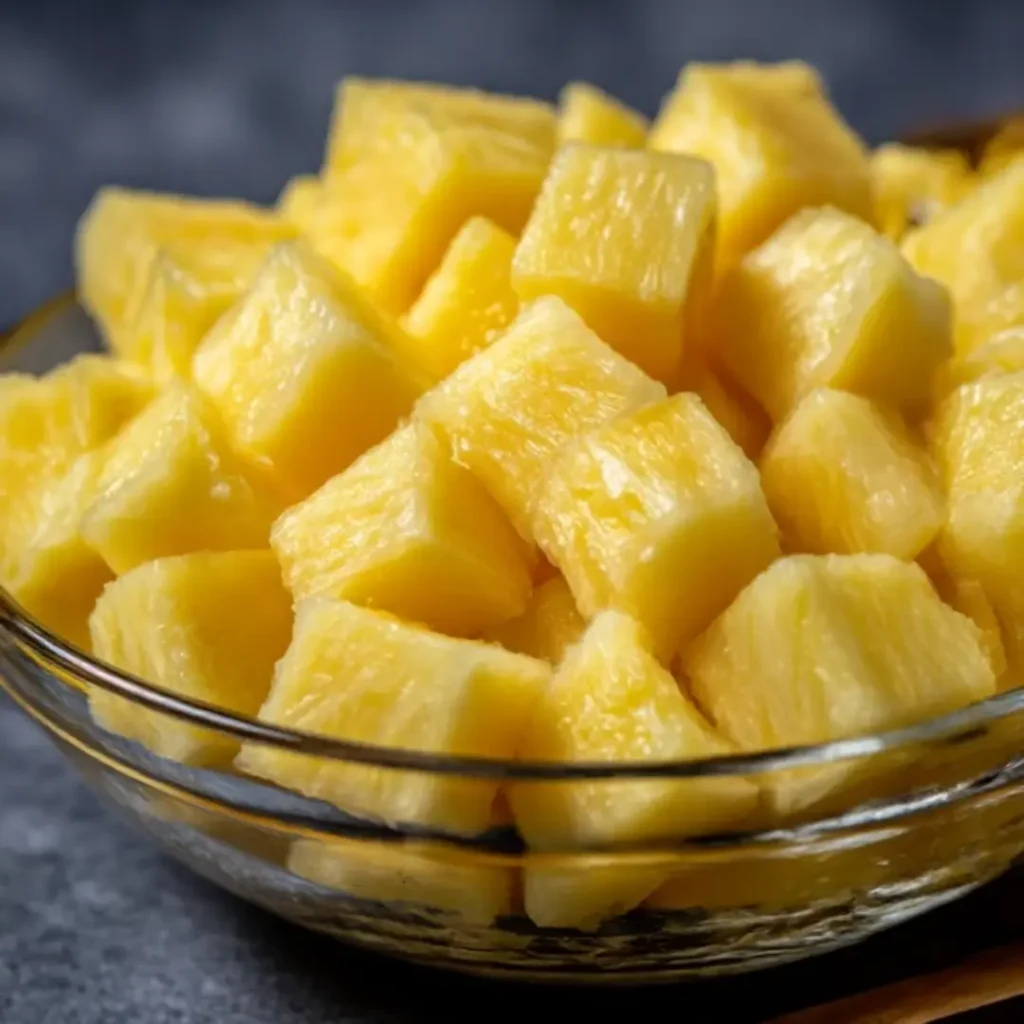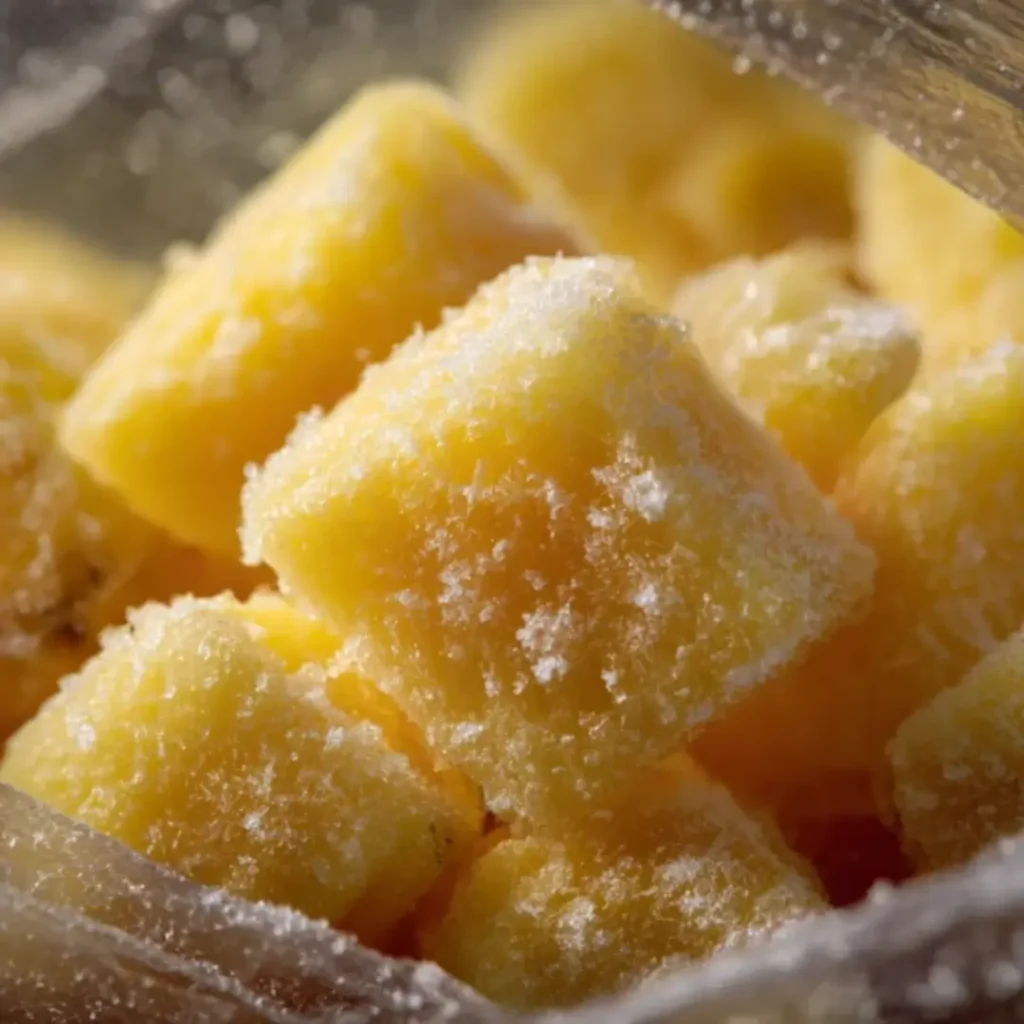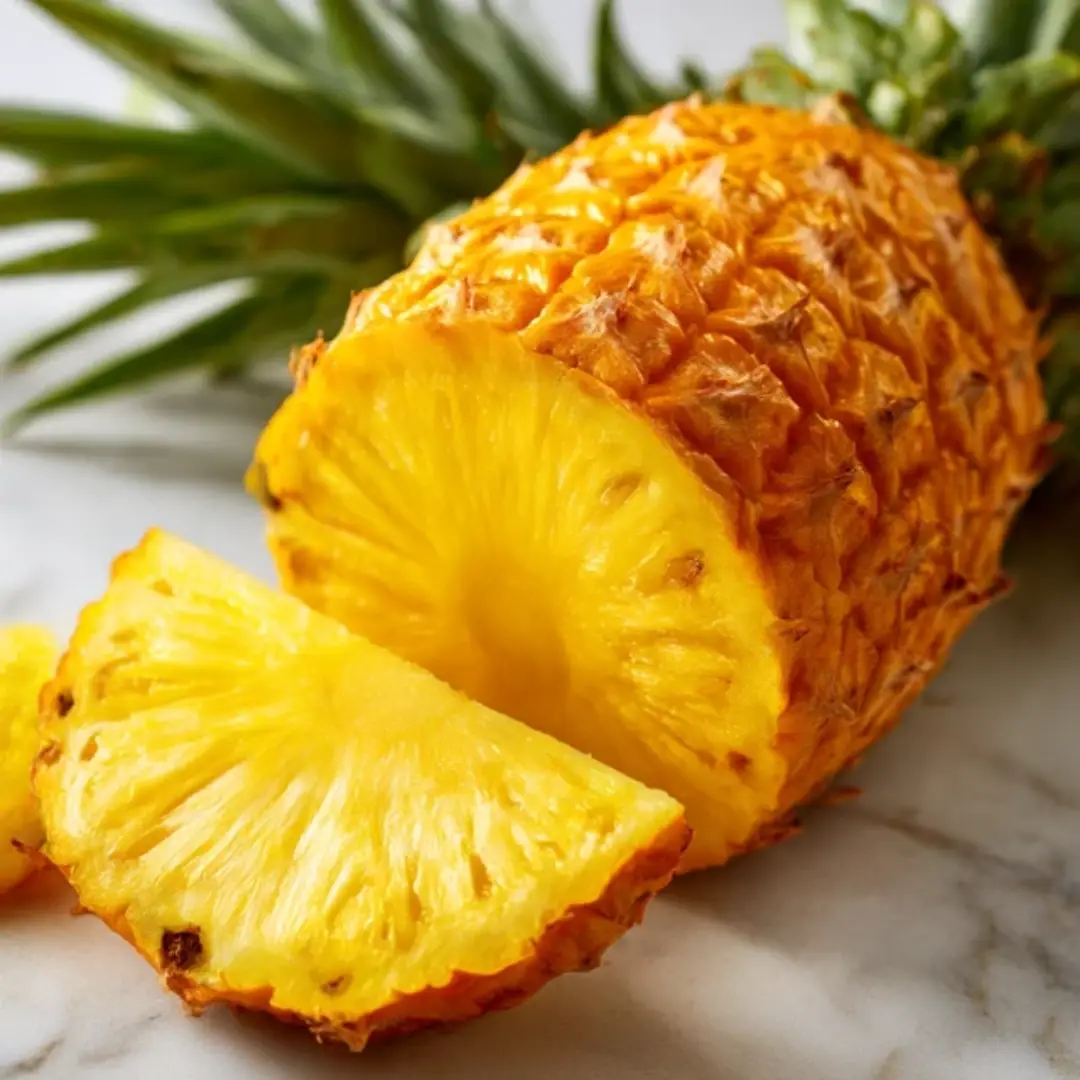The Ultimate Guide to Pineapple is the perfect resource to explore everything about this tropical fruit. Pineapple, often regarded as one of the most delicious tropical fruits, brings a refreshing burst of sweetness to any meal. Whether you’re looking to enjoy it fresh, in smoothies, or incorporated into savory dishes, The Ultimate Guide to Pineapple will help you master this versatile fruit.
In this comprehensive guide, we’ll show you how to select the best pineapples at the store, how to properly cut and store them, and creative ways to use them in your cooking. We’ll also cover the numerous health benefits of pineapple and answer some common questions like how to tell when it’s ripe. Whether you’re a seasoned pineapple lover or new to the fruit, this guide will ensure you make the most of this tropical delight.
Table of Contents
Understanding Pineapple: The Basics
What Is a Pineapple
Pineapple (Ananas comosus) is a tropical fruit that belongs to the Bromeliaceae family. Native to South America, particularly Brazil and Paraguay, pineapples are grown on tall, spiky plants. The fruit itself is known for its tough, leathery skin and sweet, tangy flesh inside. In The Ultimate Guide to Pineapple, we’ll explore how this tropical fruit is cultivated, how it grows, and what makes it stand out among other fruits.
The Nutritional Benefits of Pineapple
Not only is pineapple delicious, but it’s also loaded with health benefits. The Ultimate Guide to Pineapple wouldn’t be complete without diving into its nutritional value. Here are some of the top reasons to enjoy pineapple:
- Packed with Vitamin C: Pineapple is a rich source of Vitamin C, which supports the immune system and helps maintain healthy skin. A single cup of pineapple provides over 100% of your daily recommended intake of Vitamin C.
- Great for Digestion: Thanks to bromelain, a powerful enzyme, pineapple aids in digestion by breaking down proteins and reducing inflammation in the body.
- High in Fiber: Pineapple is high in dietary fiber, helping to keep your digestive system running smoothly and promoting overall gut health.
- Low in Calories: At just 80 calories per cup, pineapple makes for a healthy, low-calorie snack that can fit into any diet plan.
As you can see, The Ultimate Guide to Pineapple isn’t just about how to enjoy the fruit—it’s also about understanding its health benefits and how it contributes to your well-being. Now that you know the basics, let’s move on to how to select the perfect pineapple in the next section!
Pineapple is a great addition to a healthy breakfast. For some ideas, check out these Vegan Breakfast Recipes

Pineapple Smoothie Bowl
- Total Time: 5 minutes
- Yield: 1–2 servings 1x
Description
This Pineapple Smoothie is the perfect blend of tropical sweetness and creamy goodness! Made with fresh, frozen pineapple chunks, banana, and a splash of coconut milk, it’s a refreshing, nutrient-packed drink that’s quick and easy to make. Whether you’re looking for a healthy breakfast, a post-workout snack, or a cool treat on a warm day, this smoothie delivers a burst of flavor and energy. Plus, it’s customizable—add Greek yogurt for extra creaminess or ice for a thicker texture. Enjoy the natural sweetness of pineapple while reaping its many health benefits in every sip!
Ingredients
1 cup frozen pineapple chunks
1/2 banana
1/2 cup coconut milk (or any milk of your choice)
1/2 cup orange juice
1/4 cup Greek yogurt (optional, for added creaminess)
Ice cubes (optional, for a thicker texture)
Instructions
Add the frozen pineapple chunks, banana, coconut milk, orange juice, and Greek yogurt (if using) into a blender
.Blend until smooth and creamy. Add ice cubes if you want a thicker smoothie.
Pour into a glass and enjoy immediately!
Notes
Sweetness Adjustment: If you prefer a sweeter smoothie, you can add a small drizzle of honey or maple syrup to taste. The banana and pineapple already provide natural sweetness, but you can adjust based on your preference.
Dairy-Free Option: To make this smoothie dairy-free, simply omit the Greek yogurt or use a dairy-free yogurt alternative like coconut yogurt or almond milk yogurt.Thickening: For a thicker smoothie, add a handful of ice cubes or use frozen banana slices instead of fresh banana.
Boost Your Smoothie: To add more nutritional value, you can include chia seeds, flax seeds, or a scoop of protein powder.
Make Ahead: You can prep the ingredients the night before by placing the frozen pineapple, banana, and any other add-ins into a bag or container. In the morning, just blend with your liquids for a quick, ready-to-go smoothie.
Make Ahead: You can prep the ingredients the night before by placing the frozen pineapple, banana, and any other add-ins into a bag or container. In the morning, just blend with your liquids for a quick, ready-to-go smoothie.
- Prep Time: 5 minutes
- Cook Time: 0 minutes
- Category: Breakfast
- Method: Blending
- Cuisine: Tropical, Healthy
Nutrition
- Serving Size: 1-2 servings
- Sugar: 25g
- Sodium: 25mg
- Fat: 3g
- Saturated Fat: 1g
- Unsaturated Fat: 2g
- Trans Fat: 0g
- Carbohydrates: 35g
- Fiber: 4g
- Protein: 2g
- Cholesterol: 0mg
Keywords: Pineapple smoothie, easy smoothie , fruit smoothie
How to Select a Perfect Pineapple
Signs of a Ripe Pineapple
To select the perfect pineapple, keep an eye out for these signs of ripeness:
- Color: The base of the pineapple should be golden yellow, which indicates it’s ripe. While the top may still have some green, the golden color at the base suggests it’s ready to eat.
- Smell: A ripe pineapple will have a sweet, fragrant smell at the base. If there’s no smell, it may be under-ripe. A sour or fermented odor means the pineapple is likely overripe.
- Firmness: Gently squeeze the pineapple. It should feel firm but give slightly under pressure. If it’s too soft, it may be overripe.
- Leaves: The leaves at the top should be green and fresh. If they’re brown or dry, the pineapple may be overripe. Tugging on the leaves can also help—if they come out easily, the fruit is likely ripe.
Tips for Picking a Fresh Pineapple
In addition to these signs, here are a few more tips to help you pick the freshest pineapple:
- Focus on Quality: Larger pineapples may seem appealing, but size doesn’t necessarily mean better quality. Look for one that shows the signs of ripeness.
- Look for Damage: Avoid pineapples with visible bruises, soft spots, or deep dents, as these could indicate that the fruit is overripe or damaged.
- Ripen at Home: If you don’t find a perfectly ripe pineapple, don’t worry! You can leave it at room temperature to ripen naturally over a few days.
By following these tips, you’ll be able to choose the best pineapple for any dish or snack. Next, let’s move on to how to properly cut and prepare your pineapple for use
Once you’ve selected the perfect pineapple, try adding it to a delicious Strawberry Poke Cake for a delightful tropical twist
How to Cut and Prepare Pineapple
Step-by-Step Guide for Cutting Pineapple
Follow these simple steps to cut and prepare pineapple like a pro:
- Remove the Top and Bottom: Start by cutting off the top and bottom of the pineapple. This creates a flat surface, making it more stable as you work.
- Peel the Pineapple: Stand the pineapple upright and slice off the skin, following the natural curve of the fruit. Be sure to remove all the “eyes” (small brown spots) along the way.
- Cut the Pineapple into Quarters: Once the skin is gone, cut the pineapple in half lengthwise, then slice each half into quarters. This makes it easy to remove the tough core.
- Remove the Core: The pineapple core is fibrous and tough, so it’s best to cut it out. Use a small knife to cut along the center of each quarter, removing the core.
- Slice into Pieces: Once the core is removed, you can cut the pineapple into rings, chunks, or wedges, depending on your preference and how you plan to use it.
Different Ways to Serve Pineapple
Once your pineapple is prepared, here are a few ways to enjoy it, as suggested in The Ultimate Guide to Pineapple:
- Fresh Pineapple Chunks: Serve fresh pineapple chunks as a quick snack or add them to a fruit salad.
- Grilled Pineapple: For a smoky, caramelized flavor, grill pineapple slices and drizzle with honey or lime juice.
- Pineapple Smoothies: Add pineapple to your smoothies for a tropical and refreshing twist.
- Pineapple Rings for Desserts: Grilled pineapple rings can make a delicious dessert topping or be enjoyed on their own.
By following these easy steps, you can prepare pineapple for any occasion. In the next section of The Ultimate Guide to Pineapple, we’ll show you how to store it and keep it fresh for longer.
Storing Pineapple: How to Keep It Fresh Longer
Proper Storage Techniques for Pineapple

Here are the best practices for storing pineapple:
- Whole Pineapple: If your pineapple is still uncut, leave it at room temperature to ripen fully. Once it’s ripe, transfer it to the fridge to extend its freshness. A whole pineapple can stay fresh for 3–5 days at room temperature and up to a week in the fridge.
- Cut Pineapple: After cutting, store the pieces in an airtight container and refrigerate them. This will keep the fruit fresh for 3–5 days. Always ensure the container is tightly sealed to prevent moisture loss and drying.
- Avoid Storing in Open Containers: If you store cut pineapple in an open container, it will dry out quickly. Always use a sealed container to maintain its freshness.
How to Store Pineapple for Longer
If you want to keep pineapple for an extended period, freezing is a great option. Here’s how to freeze it properly:
- Freezing Pineapple: Cut the pineapple into chunks or slices. Lay the pieces in a single layer on a baking sheet and freeze for 2–3 hours. Afterward, transfer the pieces into a freezer-safe bag or airtight container. Frozen pineapple can last up to 6 months.
- Freezing Pineapple in Syrup: For a sweeter option, freeze pineapple in syrup. Place the chunks in a container and cover them with a mixture of sugar and water. This method helps preserve the fruit’s texture and sweetness.
With these storage tips, you can keep your pineapple fresh and enjoy it for a longer period. In the next section, we’ll cover how to use frozen pineapple in smoothies and other recipes.
After cutting your pineapple, why not try it in a refreshing ice cream dessert? Check out our Plum Ice Cream Recipes, where pineapple can be a great addition
Freezing Pineapple: Everything You Need to Know
Can You Freeze Pineapple?

Yes, freezing pineapple is an excellent way to store it and enjoy its tropical flavor long after it’s out of season. Whether you have leftovers or want to stock up, freezing keeps the fruit fresh and flavorful.
How to Freeze Pineapple Properly
Follow these steps to freeze pineapple while maintaining its texture and taste:
- Cut the Pineapple: Start by peeling the fruit and removing the core. Cut the pineapple into chunks or slices, depending on your intended use.
- Flash Freeze the Pieces: Lay the pineapple pieces in a single layer on a baking sheet. Freeze them for 2-3 hours until the pieces are solid and firm.
- Transfer to a Freezer Bag or Container: Once frozen, place the pieces into a freezer-safe bag or airtight container. Remove as much air as possible to avoid freezer burn. Label the container with the date it was frozen.
- Store in the Freezer: The frozen pineapple will stay good for up to 6 months. For the best quality, try to use it within this time frame.
Freezing Pineapple in Syrup
If you prefer a sweeter option, freeze pineapple in syrup. Here’s how:
- Prepare the Syrup: Combine water and sugar in a 2:1 ratio and bring to a boil until the sugar dissolves. Let the syrup cool before using it.
- Submerge the Pineapple: Add the pineapple chunks to a container and cover them with the cooled syrup. This helps preserve the texture and sweetness.
- Freeze the Pineapple: Seal the container and store it in the freezer. Pineapple stored this way will last for up to 6 months.
These methods will help you enjoy frozen pineapple in smoothies, desserts, and other recipes. In the next section, we’ll cover how to incorporate frozen pineapple into your cooking.
Pineapple Health Benefits: More Than Just a Sweet Treat
The Power of Bromelain in Pineapple
Pineapple contains an enzyme called bromelain, which has a number of health benefits. This enzyme helps break down proteins, aiding in digestion. Bromelain also possesses powerful anti-inflammatory properties, which may help reduce swelling and pain, particularly after surgery or injury. Additionally, bromelain can improve symptoms of arthritis and promote better joint health, making it a great natural remedy for inflammation.
Pineapple for Digestive Health
One of the key reasons to include pineapple in your diet is its ability to support digestive health. The high fiber content of pineapple helps keep your digestive system running smoothly, preventing constipation and promoting regular bowel movements. Bromelain also aids digestion by breaking down proteins, making it easier for your body to absorb nutrients from food. In The Ultimate Guide to Pineapple, we emphasize the digestive benefits this fruit provides to support overall gut health.
Boosting Your Immune System
Another significant health benefit of pineapple is its high content of vitamin C, a powerful nutrient that helps strengthen your immune system. Vitamin C plays an essential role in producing white blood cells, which are crucial for fighting off infections. By regularly consuming pineapple, you can boost your immune defenses and reduce the duration of colds and illnesses.
Reducing Inflammation and Pain
The anti-inflammatory effects of bromelain make pineapple a great natural remedy for inflammation. The Ultimate Guide to Pineapple highlights how regular consumption of pineapple may help reduce inflammation in the body, which can alleviate conditions like muscle strains, joint pain, and even sinusitis. If you’re looking to manage chronic inflammation, incorporating pineapple into your diet may offer natural relief.
Promoting Healthy Skin
Vitamin C is also essential for maintaining healthy skin, and pineapple is a rich source. This vitamin supports the production of collagen, which helps maintain skin elasticity and smoothness. In addition to eating pineapple, its extract can be used topically to promote skin healing and reduce signs of aging, such as wrinkles. With regular consumption, pineapple can contribute to a glowing, youthful complexion.
Aiding Weight Loss
If you’re trying to lose or maintain weight, pineapple can be a helpful addition to your diet. The fruit is low in calories but high in water content, which helps you feel full and satisfied. The fiber in pineapple also promotes a sense of fullness, reducing hunger and cravings. Additionally, the enzymes in pineapple can help boost your metabolism, making it easier to burn fat and maintain a healthy weight.
Common Pineapple Problems: What You Need to Know
What’s the White Stuff on Cut Pineapple?
You may have noticed some white spots or a fibrous layer on cut pineapple. In The Ultimate Guide to Pineapple, we explain that these white areas are simply the natural fibers of the fruit, which are completely safe to eat. However, some people find them a bit tough or unpleasant. You can easily remove them by cutting around the spots or scraping them off with a knife. This doesn’t affect the taste, and you can enjoy the rest of the fruit without any issues.
Can You Eat Pineapple Skin
The skin of the pineapple is tough and inedible. While it’s not meant for consumption, you can use it in other ways. In The Ultimate Guide to Pineapple, we suggest saving the skin for making pineapple juice or adding it to smoothies for an extra burst of flavor. Just make sure to wash it thoroughly before using it for these purposes, as the skin may contain pesticides or dirt.
How to Tell When a Pineapple Is Ripe
In The Ultimate Guide to Pineapple, we emphasize the importance of knowing when your pineapple is ripe for the best flavor. A ripe pineapple will have a golden-yellow color at the base, and it will give off a sweet fragrance when you smell it near the bottom. The leaves should be green and fresh, and when you pull on them, they should come out easily. A slight softness at the base is also a good indicator that the pineapple is ready to eat.
Can Pineapple Go Bad
Just like any other fruit, pineapple can go bad if not stored properly. In The Ultimate Guide to Pineapple, we explain how to spot spoiled pineapple: look for an off smell, mold, or a slimy texture. To avoid this, always refrigerate your cut pineapple, and consume it within 3-5 days. Freezing the fruit will extend its shelf life for up to 6 months, making it perfect for later use.
Dealing with Pineapple’s Acidic Nature
Pineapple’s acidity can sometimes cause discomfort in the mouth, especially for sensitive individuals. This is due to the enzyme bromelain, which breaks down proteins and can irritate the mouth’s lining. In The Ultimate Guide to Pineapple, we recommend pairing pineapple with other foods to neutralize its acidity, or cooking it to reduce the sting. This makes the fruit gentler and more enjoyable, especially for those with sensitive mouths.
Once your pineapple is stored, try adding it to a creamy dessert like Strawberry Banana Pudding for a tropical treat
Creative Ways to Use Pineapple in Cooking
Pineapple in Savory Dishes

- Grilled Pineapple: Adds a smoky sweetness to burgers, tacos, or served as a side.
- Pineapple Salsa: Mix pineapple with red onion, cilantro, and chili for a fresh salsa.
- Pineapple Stir-Fry: Add pineapple chunks to stir-fries for a sweet contrast to savory flavors.
- Hawaiian Pizza: Top pizza with pineapple, ham, and cheese for a classic combination.
Pineapple in Sweet Dishes
- Pineapple Upside-Down Cake: A classic dessert with caramelized pineapple.
- Pineapple Sorbet: Blend frozen pineapple for a refreshing, dairy-free treat.
- Pineapple Muffins: Add pineapple and coconut to muffin batter for a tropical twist.
- Pineapple Panna Cotta: A creamy dessert with pineapple puree for extra flavor.
Pineapple in Drinks
- Pineapple Juice: Fresh juice on its own or mixed into cocktails and smoothies.
- Pina Colada: A tropical cocktail with pineapple juice, coconut cream, and rum.
- Pineapple Mojito: A twist on the classic mojito with pineapple and mint.
Pineapple as a Meat Marinade
Pineapple’s bromelain enzyme tenderizes meat, making it perfect for marinades, especially for pork, chicken, or beef.
Conclusion
In The Ultimate Guide to Pineapple, we’ve explored everything you need to know about this tropical fruit—from selecting and cutting the perfect pineapple to storing it properly and using it in creative recipes. Whether you enjoy it fresh, frozen, or cooked, pineapple offers not only delicious flavor but also numerous health benefits, such as boosting your immune system, aiding digestion, and supporting healthy skin.
By following the tips and ideas in this guide, you can make the most of pineapple, adding its sweet, tangy taste to both savory and sweet dishes. So, the next time you see a pineapple at the store, you’ll be ready to bring it home and enjoy it in countless ways!
For more updates, fun pineapple facts, and recipes, make sure to follow us on our Facebook page and Instagram page!
FAQs
How Can You Tell When a Pineapple Is Ripe?
A ripe pineapple has a golden-yellow base and gives off a sweet aroma. The leaves should be green and come out easily when pulled. The pineapple should also feel slightly soft at the base when gently squeezed.
Can You Freeze Pineapple?
Yes, pineapple can be frozen! Cut it into chunks or slices, freeze in a single layer on a baking sheet, then transfer to a freezer-safe bag or container. It can be stored for up to 6 months.
What’s the White Stuff on Cut Pineapple?
The white spots on pineapple are natural fibers from the fruit. They are safe to eat, but if you don’t like the texture, you can remove them before consuming.
Can You Eat Pineapple Skin?
No, pineapple skin is tough and not edible. It can, however, be used to make juices or smoothies if washed thoroughly.





